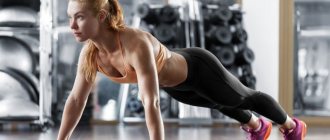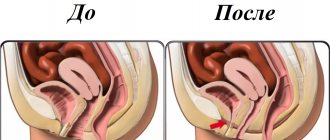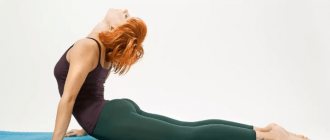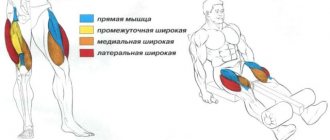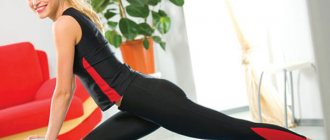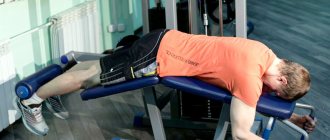The benefits of cardio training
Cardio training is the best thing you can think of to combat excess weight, increase endurance and get rid of negative thoughts. While running or swimming, you, of course, will not be able to set records for push-ups, but you will be ensured of vigor and the ability to spend a long time in motion.
What other benefits do cardio exercises provide?
- strengthening the cardiovascular system;
- respiratory system training;
- increasing the body's endurance;
- increased tissue density;
- muscle strengthening;
- lowering cholesterol levels;
- improving metabolism, that is, increasing metabolic rate;
- improving the ability of muscle tissue to process glucose, that is, preventing diabetes;
- production of endorphins and improvement of hormonal levels.
What is cardio?
Cardio workout
– This is primarily training
the cardiovascular
(cardiovascular) system. Cardio is performed at a low to high intensity range and is based primarily on the aerobic energy system. The words are not very clear, I agree. Now I'll try to explain. To determine what constitutes cardio training, you need to know 2 main systems (mechanisms) for energy production in the body:
- Aerobic oxidative system
- the body only needs oxygen to meet its energy needs. - Anaerobic oxidative system
- the body switches from oxygen to ATP and glycogen.
The aerobic oxidative system is more efficient [1] (you can run at a moderate pace for a long time). However, the anaerobic oxidative system is capable of providing large amounts of energy in a very short period of time. It is used during strength training and very fast movements [1] (a classic example is sprinting).
Effects of Cardio
Everyone needs cardio training
- not only for keeping fit, but also for health in general. Here's what cardio does:
- Burns fat and helps recover after strength training, as read below.
- Increases aerobic power (VO2max) [2] . In simple terms, cardio increases the ability of cells to efficiently utilize oxygen. As a result, you can train longer and more intensely, and the onset of fatigue is delayed.
- Relaxes blood vessels [3]. This helps normalize blood pressure . A positive effect on blood pressure levels is also achieved due to the ability of cardio to combat psychological/physical stress and anxiety [4].
- Increases blood circulation [5], due to which the muscles receive more nutrients and “garbage” (toxins) is removed from them. In addition, toxins are eliminated through sweat [6].
- Reduces the level of “bad” cholesterol and increases “good” cholesterol [7].
- Promotes the digestion of food and has a positive effect on the gastrointestinal tract [8].
- Fights depression [4], gives a feeling of energy [9], well-being [10], and also increases life expectancy [11].
Cardio for fat burning
Cardio training has a number of effects that are beneficial for fat burning:
- Cardio is great for burning calories
. An hour-long cardio workout at a moderate pace consumes about 600 kcal (1 min ≈ 10 kcal [12]). - After a cardio workout, your body continues to burn additional calories for up to 24 hours [13]. This phenomenon is known as EPOC (excess post-exercise oxygen consumption
).
It occurs due to the need for muscle recovery after exercise. EPOC
is 6-15% of calories burned during moderate-intensity cardio training [14], that is, if you burned 500 kcal, another 30-75 will “burn out” during the day. And after HIIT, the additional calorie consumption will be about 100 kcal [15]. - Cardio exercise increases the body's insulin sensitivity
and
reduces spikes in blood sugar
after meals [16]. High insulin sensitivity causes more energy to be stored in muscle and less in fat.
However, the role of cardio training for fat loss should not be overestimated. The most important component in this case is nutrition with a calorie deficit [17]. If you eat too much, you won't burn fat. Strength training is next in importance. It boosts your metabolism for 48 hours [18] (rather than 24 like cardio) and builds muscle. And the more muscles, the more energy they consume.
Conclusion:
Cardio is very
useful, BUT it is not necessary for fat burning.
It acts as a complement to proper nutrition and strength training.
Contraindications
Most types of cardio training are available to a wide range of people, but if a person has any heart problems, has had a stroke or heart attack, then it is necessary to see a doctor before starting classes. The same recommendation applies to those who are obese, have diabetes, cancer, or have serious problems with joints and knees.
Whether it’s seemingly easy running or exotic canoeing, the duration and intensity of exercise should not be increased sharply. Start with light and short workouts, monitor your heart rate and stick to the rule of increasing the load by 10% per week.
Exercise bike - safe and effective
This type of exercise machine is the main competitor to street running in the morning; all exercises can be performed in the comfortable conditions of the gym. Modern equipment is equipped with electronic sensors that make it possible to monitor the intensity and control the situation.
In combination with an exercise bike, it is better to use elliptical sports equipment, a treadmill and steppers. This will help you work all muscle groups and effectively get rid of excess fat.
A more detailed description of cardio equipment can be found here.
Duration of cardio training
Whether you're looking to lose weight or improve your endurance, ten minutes of cardio won't cut it. The minimum recommended duration of cardio training is 30 minutes, which is the time when glycogen stores are depleted. However, do not forget that a previously untrained person can start with 10 minutes of exercise, gradually increasing the time to 60 minutes.
When losing weight, a long duration is important because the burning of fat deposits begins only after glycogen reserves are used up. To lose weight, you need to exercise either for a long time or intensely. In this sense, exercising in the morning on an empty stomach, when the body has low glycogen reserves, is good.
Training plans for marathon and half marathon. and start preparing today.
Important: you lose weight not because you exercise yourself, but because you create a calorie deficit. Together with exercise, this is much easier to bear, but do not forget to eat right to achieve the desired effect.
Before or after strength training?
Is it possible to combine cardio and strength training in one day? You can and should, but never do cardio before lifting weights.
. In this case, your glycogen stores will run out. Respectively:
- there will be little energy on the power supply;
- you will do less work;
- muscle hypertrophy will be less;
- Fatigue increases the risk of injury.
Another reason not to do cardio before strength training is mTOR inhibition.
signaling complex that ensures muscle growth.
This makes it even more difficult to gain muscle mass.
A study by Goto K. et al. [39] showed that moderate static cardio training immediately after strength training burned more
fat
compared to doing cardio alone. At the same time, the break between strength and cardio training should be short (up to 20 minutes).
Conclusion:
do cardio after you finish lifting weights or during your free time/rest day. If your goal is to burn fat, the best time to do cardio is immediately after strength training.
Cardio intensity
The intensity of your activities can be monitored by your heart rate, which will be measured by a heart rate monitor. To achieve optimal cardiovascular performance, train between 60-90% of your maximum heart rate.
Maximum heart rate can be estimated by subtracting age from 220 - this is the simplest formula. For example, the estimated maximum heart rate for a 37-year-old person would be:
220 - 37 (age in years) = 183 beats per minute
Read on the topic: Pulse zones: what heart rate to run at
When is it better to do cardio: morning or evening
The time of day at which it is best to train depends on the goals of the practitioner.
The morning is suitable for those who want to lose weight, because during the night almost all of the glucose has been used up, and the body will quickly switch to fat burning. Morning cardio is very invigorating, unless you find it painful to get out of bed early.
Daytime exercise strengthens the heart. At this time, since the person has already eaten more than once, the body has enough nutrients and energy. But the body can switch to a fat-burning mode only 30-40 minutes after the start of the lesson.
Evening activities can be similar to morning and afternoon ones: it all depends on when you eat. To lose excess weight, at least 1.5-2 hours should pass between cardio exercise and meals, and after training it is better to eat food that does not contain carbohydrates.
Types of Cardio Training
Run
Running is the first thing that comes to mind when talking about cardio. Indeed, this is the most accessible and simplest type of cardio exercise. However, it is important that the student does not have problems with his knees, and that he runs in shoes suitable for this. Running either on the street or on a track in a fitness club will be equally beneficial for the body, but it is more pleasant and best to run in a forested area on the ground.
If you haven't run before, start with 20-minute sessions, alternating between walking and running. When you cross the threshold of 10 minutes of continuous running, add 1-3 minutes to it. To improve your health, three workouts a week will be enough.
Health running: benefits and contraindications
There is also a fun and time-saving option in running – canicross, or running with a dog. You still walk your pet in the morning and evening, so why not replace the walk with a run? Most dogs will definitely be happy with this transformation of their walks.
Cross-country skiing
Don’t want to run in winter and don’t want to stop doing cardio? Cross-country skiing is the way to go. Of course, you will have to spend more time on a ski lesson to get to the ski track, but how fresh it is in the forest in winter!
Unlike running, this type of cardio has a low impact factor on tendons, ligaments and muscles, so it's not that easy to get injured from overuse. Skiing is also good because it uses not only the lower body, but also the upper body, and therefore it is an excellent comprehensive workout for the whole body.
Considering the fact that in Russian cities there are no ski tracks in every park, most likely you will be able to go on a ski trip no more than twice a week. Therefore, think about what other type of affordable cardio you should choose for weekdays.
Bike
Cycling beats all types of cardio workouts by adding an element of travel to your workout. On weekends, if you have enough riding experience, you can easily go out into nature outside the city, receiving a lot of positive emotions from getting to know new places.
When you pedal, your bones and joints are not subject to repeated shock. Well, to spin them, you don’t have to buy a bicycle, worry about its serviceability during operation, ride around the city or wait for suitable weather. You can “ride” a bicycle in the fitness room or at home, using an exercise bike or machine. The effect on the body will be the same.
How to choose a bike station for training at home
Cycling
At first glance, cycling is similar to cycling, but the difference between these two types is about the same as between running and skiing. In cycling, the load, in addition to the legs, goes to the upper body.
Cycling is intense cardio, so it is not recommended for people with diseases of the cardiovascular system. For beginners who get off the couch, it will be difficult in the first classes; to begin with, it is better to get by with a calm type of cardio training.
Due to the high intensity of cycling, classes 2-3 times a week will be enough for you. Read more about it in the article: What is cycling and can it replace cycling?
Walking
Walking is the best solution for people with heart disease, obesity and for those who cannot find time to exercise. Agree, you can just take a walk during your lunch break, walk the dog longer, get off 2-3 stops earlier, or park your car further away. Over the course of the day, an hour of walking will accumulate, that is, an average of 5 kilometers.
Walking: types, benefits, calorie consumption
You can and should walk every day: there is no high load on the heart, joints and muscles. For the best healing and fat-burning effect, try to walk quickly or alternate between fast walking and walking that is comfortable for you.
Walking option - Nordic walking. It involves up to 90% of the muscles and is considered very effective for healing and losing weight. This is not the case with running or cycling. But to use all these muscles, technique is important when walking with poles. To do this, take 5-7 lessons from an instructor.
Jump rope
Jumping rope is an affordable home workout that will build endurance, strengthen muscles and improve coordination. For those who run, jumping rope is a good way to practice cadence and reduce foot contact time.
The main problem with a jump rope is that jumping for more than 5 minutes is boring, but the effect of cardio begins only after 40 minutes! In this regard, a jump rope can become an addition to training, but not the main type.
For example: twice a week you can go to a cycling studio, and 1-2 times a week jump rope at home. Various training complexes will help to diversify your jumps, including jumping on one leg, push-ups, burpees, and squats.
Jump rope for runners: benefits, technique, training
Swimming
Swimming in a pool or open water spares your joints and tendons the wear and tear that comes with many other workouts. However, swimming uses a lot of muscles without forcing a person to go to high intensity. You can keep your heart rate in the aerobic zone for a long time without getting as tired as, for example, skiing.
The benefits of swimming: 20 reasons to go to the pool
However, if you want the effect of classes, forget about long breaks at the side. It will be better if you can swim without stopping. Swimming has many techniques - crawl, breaststroke, butterfly, backstroke - and they all put more or less stress on certain muscle groups. If you pay attention to a specific technique in each workout, you can comprehensively develop your body.
For runners, skiers, and cyclists, swimming is the best recovery workout. Calm swimming allows your legs to rest and relieve muscle soreness faster.
Ellipsoid
The movements on the elliptical trainer are similar to running and skiing at the same time. Exercises on this equipment involve almost all muscle groups - up to 80%, and due to the elliptical trajectory of movement there is no high load on the joints. If you didn’t know, you can pedal backwards on an elliptical, putting a strain on muscles that are not so easy to work in other types of cardio.
A noticeable advantage of the ellipsoid is that you do not need to specially learn the technique of movements - the amplitude of movements on it is preset.
Rowing machine
Rowing is available to just a few, and a rowing machine with a countdown of the distance traveled and power will meet you in most modern fitness clubs. This is both cardio and strength training, which involves the muscles of the arms, legs and back, according to various sources, from 80 to 95% of the muscles.
A rowing machine can build endurance and strength in a way that running, walking and cycling cannot. In general, in terms of the load on the human body, it is very similar to skiing. The rowing machine keeps your heart rate at a moderate intensity, and 20-60 minutes of high-intensity exercise 3 times a week will be sufficient.
Crossfit
Functional training, developed by the CrossFit corporation, is now at the peak of popularity, because it is not for nothing that the word “CrossFit”, which is a brand, has become used everywhere when it comes to combining cardio exercise with gymnastics and strength exercises.
CrossFit is a circuit training where you need to complete a certain complex while spending as little time as possible. These are high-intensity workouts, and you should only approach them if there are no contraindications to long-term work.
There are so many different exercises for endurance, strength, and flexibility in CrossFit that the trainer will offer you something new at every lesson. But if you are very passionate about these workouts, it is advisable to still give yourself a day of rest before your next visit to the gym.
Water aerobics
Water procedures are not only about swimming. Water aerobics is created for those who quickly get bored of swimming from side to side. Water aerobics classes take place in a swimming pool under the guidance of a trainer who shows the group the exercises to music.
Since all this is done through the resistance of water, the muscles also receive sufficient stress. Water, in addition, here acts as support for the musculoskeletal system, reducing unnecessary stress on it. Water aerobics is one of the most non-traumatic types of human physical activity.
Despite the fact that water aerobics exercises involve almost all muscle groups, muscle tension is relieved in water, so such training will be a good addition to basic cycling/skiing/running and other training on land.
Step aerobics
Step aerobics has all the benefits of a high-intensity cardio workout without the stress on your joints. During the classes, a height-adjustable step platform is used, on which various choreographic combinations of steps are performed at a fast pace. Dumbbells can also be used to increase the load.
Step aerobics refers to cardio, where the load throughout the entire session is above average: you cannot stop for 45-60 minutes, rest in the form of a step in place is given after a set of intense steps.
As for working muscles, in step aerobics the main emphasis is on the lower body. To improve your body comprehensively, you will need separate exercises for your arms, chest and abs.
Fitbox
A mixture of martial arts, strength training, aerobic exercise, a self-defense lesson - all this is a new type of fitness called fitbox. Punches and kicks on a punching bag are done at an accelerated pace to rhythmic music, which causes the pulse to accelerate to the anaerobic zone, which trains physical endurance.
Fitbox is somewhat similar in structure to cycling: the trainer forces the group to constantly move and perform strength exercises between hitting the punching bag.
Don’t be afraid to go to fitbox training: unlike regular boxing, there is no sparring, which means there is no pain, bruises and abrasions.
Ski simulator
Classes on a ski simulator can be either a year-round addition to cross-country skiing or an independent form of physical activity. One thing is for sure: the ski trainer will get your heart racing very quickly. The whole body will be involved in the work: the hands here pull the rope, the hips and knees bend to push, the abs hold the torso.
Unfortunately, ski simulators are not common in Russian fitness clubs, but a good replacement can be a ski expander - a sports equipment in the form of a cord with handles, which can be used either in the gym or on the playground near the house.
The expander is also effective because it can be used to perform exercises that not only imitate skiing, but also any other exercises to strengthen different muscle groups. 25-30 minutes of such training 2-3 times a week will be enough.
Rock climbing
It would seem how far rock climbing is from cyclic sports that act as cardio engines, which, however, does not prevent the heart from beating faster when climbing.
Rock climbing in the mountains is a difficult and technical sport, but climbing indoors at a climbing wall is accessible to everyone, even those who are afraid of heights. Rock climbing requires dexterity, coordination, strength of arms, legs, and in general, while climbing, a person constantly tenses the muscles of the body, so it is even similar to running.
Only, unlike running and cycling, in rock climbing the upper body does not receive even the slightest rest, and the alternation of a concentric load mode (holding a pose) and an eccentric load (moving) awakens to work even those muscles whose existence you did not suspect. On average, you can spend 500 kcal per hour at the climbing wall.
As a comprehensive full-body workout instead of weights in the gym, this is a great option that also involves the brain in the work. Completing a climbing route is like a game of chess.
Stair running or walking
Walking or running up the stairs is available to residents of multi-storey buildings at any time of the year and in any weather. This load is much more intense than regular jogging, and the heart rate will most likely remain in the aerobic zone throughout the session, improving cardio endurance.
Running up the stairs is both a strength and cardio workout. In this case, the high impact is not only on the heart, but also on the leg muscles. Thanks to the stairs, your legs will become much stronger than they could become from regular flat running.
Stair running for 10 minutes 3 times a week already after 6 weeks gives a significant increase in general functional indicators - heart rate, recovery time, breathing rate, exercise tolerance. Like cycling, walking and stair running are considered moderate to above average cardio intensity, so three sessions per week, if there are no others, will be enough.
Stair running: recommendations and training plan
Coordination ladder
This sports equipment is often used in training football players, basketball players and skiers. The coordination ladder forces a person to make a burst of speed while at the same time controlling balance, agility and coordination.
Given the explosive nature of the work, the load from such equipment with limited rest between intervals will be above average. You can run through such stairs in different ways: forward, sideways, jumping, cross-step. All of these different variations of the exercise will help you avoid burnout and plateau in your form.
The simulator does not take up much space, you can exercise with it anywhere.
Skating
In winter, cyclists are recommended to do speed skating, which uses the same muscle groups. If you don’t know about this, then it won’t even occur to you that cycling and speed skating are so similar: by the way, they switch from skating to cycling quite often.
Not to say that this is a mass sport, but, nevertheless, in the winter season in Russian cities there are quite a lot of flooded ice skating rinks, where you can rack up kilometers in a circle. As a cross-training option, speed skating will help add variety to your core training program and improve your balance and coordination.
Football, basketball, volleyball, tennis
We included these game sports in the selection because during the game a person is in constant motion: he runs across the entire field, jumps high, and uses the shuttle running method. The heart rate here will probably be even higher than during a calm ski walk in the forest.
Basketball, tennis and other outdoor games train agility, flexibility, coordination, and reaction along with endurance and speed. It cannot be said that team sports have a positive effect on a person’s character, tactical thinking and social skills.
Dancing
Dance training is far from routine. Such classes are always held in a group or with a partner, and therefore sometimes you don’t notice how time flies. Cardio dancing provides an aerobic workout for the entire body, toning all muscle groups, helping to avoid imbalances.
Working the same muscles over a long period of time creates stress tolerance, so that you gradually stop getting as good a workout as you once did. But dance movements are different in that they are constantly different and do not use the same muscles to the point of exhaustion.
Let's add that dancing improves your mood. In one study, depressed patients were given salsa lessons for 9 weeks. At the end of the experiment, everyone experienced an uplift in mood. The researchers attribute this to the fact that it was the combination of social interaction, exercise and concentration required to master a new skill that significantly improved the mood of all study participants.
From our selection, you understand that cardio does not end with running, cycling and swimming. You are free to engage in any type of activity, combining them, which will make your workouts varied and your body fully developed. Most importantly, do not forget about recovery, healthy eating and safety measures.
Read more: Which is better: running or cycling?
Cardio training program for fat burning
The proposed cardio training programs for burning fat are suitable for both men and women. Cardio training in the gym for girls is no different from men's.
Static cardio
| Time | Intensity |
| 0:00 – 2:00 | 4 points |
| 2:00 – 28:00 | 5 points, 66-69% HRMax (fat burning corridor) |
| 28:00 – 30:00 | 4 points |
Type of card exercise:
exercise bike, elliptical or uphill walking.
Execution frequency
: 5 times a week, after strength training (i.e. 3-4 times) and 1-2 times on rest days
Benefit
: one workout = 300 kcal, 5 workouts will burn about 1500 kcal per week + fat burning, increased endurance and other beneficial effects.
HIIT
This 4-phase cardio program for burning fat in the gym will take you from beginner to HIIT pro in 8 weeks.
Phase 1 (week 1-2).
Work-rest ratio 1:4
15 seconds - intensity 9 points;
60 seconds - intensity 7 points;
lead time
: 14 min (11 reps with a 15 second “snatch” at the end).
Phase 2 (week 3-4)
. Work-rest ratio 1:2
30 seconds - intensity 9 points;
60 seconds - intensity 7 points;
lead time
: 17 min (11 reps with a 30 second “snatch” at the end).
Phase 3 (week 5-6).
Work-rest ratio 1:1
30 seconds - intensity 9 points;
30 seconds - intensity 7 points;
lead time
: 18 minutes 30 seconds (18 reps with a 30 second “snatch” at the end).
Phase 4 (week 7-8)
. Work-rest ratio 2:1
30 seconds - intensity 9 points;
15 seconds - intensity 7 points;
lead time
: 20 minutes (26 repetitions with a 30-second “snatch” at the end).
Frequency of training according to the program
: 1-2 times a week, on rest days.
Type of cardio exercise:
exercise bike, elliptical or uphill walking.
Benefit
: Lots of calories burned, hormonal surge, fat burning, muscle growth, increased endurance!
Cardio workout without machines
Cardio can be done anywhere and without equipment , for example:
- go for a walk (light static cardio);
- do sprints (HIIT);
- jump rope (static or HIIT mode), etc.
You can find an excellent home workout program here.
